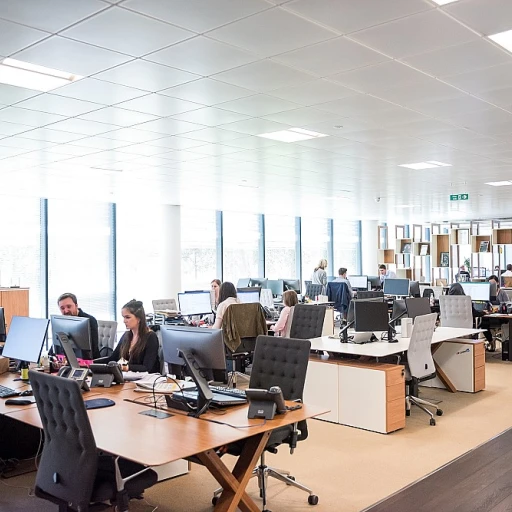Understanding the Communication Challenges in Indian Factories
Identifying Key Communication Barriers
Communication within Indian factories often faces unique challenges that can impede operational efficiency. One of the primary obstacles is the sheer diversity of languages spoken by the workforce. This linguistic variety can lead to misunderstandings and errors, especially when instructions are not clearly conveyed. Additionally, the hierarchical nature of many Indian workplaces can create barriers to open communication, where feedback might not flow freely from the ground up.
Impact of Physical and Environmental Factors
Another layer of complexity is added by the physical environment of factories. Noise levels, machinery layout, and the fast-paced nature of production lines can all contribute to communication breakdowns. In such settings, traditional verbal communication methods might fall short, necessitating the use of visual aids and other tools to ensure messages are effectively communicated.
Addressing Communication Challenges
To tackle these issues, factories can benefit from implementing effective communication strategies that leverage visual aids. Whiteboards, for instance, offer a free and versatile platform for displaying important information, providing illustrations of processes, and categorizing tasks. The design of these communication tools should be intuitive and accessible, allowing all employees to easily access and understand the content displayed.
Role of Technology and Modern Solutions
Incorporating technology can further enhance communication. Digital whiteboards and applications on Android devices can offer premium features such as real-time updates and interactive content. These tools not only help streamline communication but also ensure that all employees have equal access to vital information, regardless of their position within the factory.
The Role of Visual Aids in Streamlining Processes
Visual Aids: A Game Changer in Factory Communication
In the bustling environment of Indian factories, effective communication is paramount. Visual aids, such as whiteboards, play a crucial role in streamlining processes by providing a clear display of essential information. They serve as a tableau where complex ideas can be broken down into simple illustrations, making it easier for workers to understand and execute tasks efficiently.
Whiteboards offer a free and flexible platform for sharing information. Whether it's a daily production target or a safety protocol, these visual tools ensure that everyone is on the same page. The design of the whiteboard content should be intuitive, catering to the diverse categories of tasks within the factory. By doing so, it helps in reducing errors and improving overall productivity.
Moreover, the use of whiteboards can be tailored to specific projects, allowing for quick updates and modifications. This adaptability is crucial in a dynamic factory setting where priorities can shift rapidly. Access to this information is immediate, ensuring that all workers have the necessary data at their fingertips.
For more insights on enhancing communication in Indian workplaces, you can explore our transformative guide that delves deeper into the nuances of corporate culture and communication.
Selecting the Right Whiteboard for Your Factory
Choosing the Perfect Whiteboard: Key Considerations
When it comes to enhancing communication in Indian factories, selecting the right whiteboard is crucial. The choice of a whiteboard can significantly impact how effectively information is conveyed and processes are streamlined. Here are some essential factors to consider:
- Purpose and Content: Identify the primary purpose of the whiteboard. Is it for daily updates, project management, or training sessions? Understanding this will help in deciding the size and design of the whiteboard. Consider if you need a simple tableau blanc for basic notes or a more advanced board with gridlines for detailed illustrations.
- Material and Durability: Whiteboards come in various materials, each offering different levels of durability and ease of cleaning. For high-traffic areas, investing in a premium board that withstands frequent use can be beneficial. This ensures the board remains a reliable communication tool over time.
- Accessibility and Placement: Ensure the whiteboard is placed in a location that is easily accessible to all team members. This enhances the free flow of information and encourages regular use. Consider installing boards in popular gathering spots within the factory.
- Integration with Technology: In today's digital age, some whiteboards offer integration with android apps or other digital tools, allowing for seamless sharing of information across platforms. This can be particularly useful for projects that require constant updates and feedback.
By carefully evaluating these factors, factory managers can select a whiteboard solution that not only fits their immediate needs but also supports long-term communication goals. For more insights on effective strategies in power project management, you can explore this comprehensive guide.
Implementing Whiteboard Strategies for Effective Communication
Strategic Placement for Maximum Visibility
When implementing whiteboard strategies in factories, the placement of these tools is crucial. Positioning them in high-traffic areas ensures that information is accessible to everyone. Consider locations where teams frequently gather, such as near workstations or break rooms. This strategic placement helps maximize visibility and ensures that communication is not only effective but also free from unnecessary barriers.
Designing Content for Clarity
To enhance communication, the design of the whiteboard content must be clear and concise. Using visual illustrations and tableau formats can help break down complex information into easily digestible parts. Categorizing information into sections like safety updates, production targets, and team goals can further enhance understanding. This approach not only aids in communication but also encourages staff to engage with the displayed information actively.
Utilizing Technology for Enhanced Interaction
Integrating technology, such as android applications, can transform traditional whiteboards into interactive displays. This allows for dynamic updates and real-time interaction, providing teams with the latest information. Offering access to digital tools can make the whiteboard a central hub for communication, where updates can be made instantly, and feedback can be collected efficiently.
Encouraging Regular Updates and Feedback
Regular updates to the whiteboard content are essential to keep the information relevant. Encouraging team members to provide feedback on the displayed content ensures that it remains practical and useful. This continuous improvement process not only maintains the effectiveness of communication but also fosters a culture of collaboration and openness. By doing so, factories can ensure that the whiteboard remains a popular tool for communication.
Training Staff for Optimal Use of Whiteboard Tools
Equipping Your Team for Success with Whiteboard Tools
Training staff to effectively use whiteboard solutions is a pivotal step in enhancing communication within Indian factories. The tableau of a well-trained team can transform how processes are managed and communicated. Here are some key strategies to consider:
- Interactive Training Sessions: Conduct interactive sessions that allow employees to engage with the whiteboard tools. This hands-on approach will help them understand the design and content capabilities of the whiteboards.
- Illustrations and Visual Aids: Use illustrations and visual aids to demonstrate the benefits of using whiteboards. This can include displaying popular projects or showcasing categories of tasks that can be managed more efficiently.
- Access to Resources: Provide access to free resources and premium content that can further enhance their understanding. This could include online tutorials or android apps that offer additional insights into maximizing whiteboard use.
- Regular Feedback and Adaptation: Encourage staff to give feedback on the whiteboard strategies implemented. This will help in adapting the approach to better suit the needs of the factory floor.
- Rights and Responsibilities: Clearly communicate the rights and responsibilities associated with using whiteboards. Ensure that all staff members understand their role in maintaining and updating the information displayed.
By investing in training, you empower your team to utilize whiteboard tools effectively, leading to improved communication and operational efficiency. For more insights on enhancing workplace communication, you might find this transformative guide for office managers useful.
Measuring the Impact of Whiteboard Use on Factory Efficiency
Evaluating the Effectiveness of Whiteboard Communication
To truly understand the impact of whiteboard solutions in enhancing communication within Indian factories, it is crucial to measure their effectiveness. This involves assessing various aspects of factory operations and how these tools contribute to streamlining processes.
Key Metrics to Consider
- Communication Efficiency: Evaluate how quickly and accurately information is disseminated across different departments. Whiteboards can serve as a free and accessible medium for displaying vital information, reducing the time taken for messages to reach the intended audience.
- Employee Engagement: Assess how the use of visual aids like illustrations and tableau designs on whiteboards impacts employee involvement. Engaged employees are more likely to contribute positively to projects and operational goals.
- Process Improvements: Analyze any improvements in operational processes. The right content displayed on whiteboards can help categorize tasks effectively, leading to smoother workflows.
Feedback Mechanisms
Implementing feedback mechanisms is essential to refine the use of whiteboards. Encourage staff to share their insights on the design and content displayed, ensuring it aligns with the factory's communication needs. Regular feedback will help in adapting strategies to better suit the dynamic environment of a factory.
Technology Integration
Incorporating technology, such as android-based applications, can enhance the functionality of whiteboards. This integration allows for dynamic updates and remote access to information, making it easier for managers to sign off on tasks and projects, even when not physically present.
Continuous Monitoring and Adjustment
Finally, continuous monitoring of the whiteboard's impact on factory efficiency is necessary. Regularly reviewing the communication strategies in place and making necessary adjustments ensures that the tools remain effective. This ongoing process of evaluation and refinement will help maintain a high level of operational efficiency.






